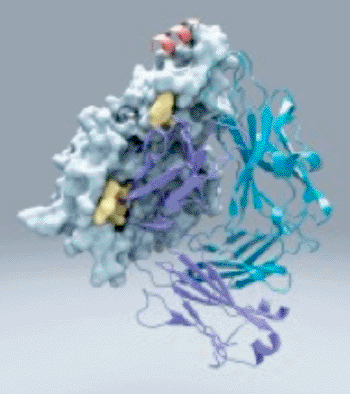A Unique Mycoplasma Protein Generically Binds All Types of Antibodies and Blocks Antigen Binding
By LabMedica International staff writers
Posted on 20 Feb 2014
A team of molecular biologists has isolated a bacterial protein that binds to all types of antibodies and prevents them attaching to their specific antigens.Posted on 20 Feb 2014
The novel protein—Protein M—may join the ranks of other nonspecific antibody binding proteins such as Protein A and Protein G as a tool for researchers seeking to purify antibodies from mixtures of other biological molecules.

Image: Protein M, an unusual bacterial protein, attaches to virtually any antibody, possibly helping bacteria establish long-term infections. Compared to thousands of known structures, this protein appears to be unique (Photo courtesy of the Scripps Research Institute).
Investigators at The Scripps Research Institute (La Jolla, CA, USA) discovered Protein M, which was being produced by the primitive bacterium Mycoplasma genitalium, during a study on the relationship between chronic bacterial infection and myeloma.
After isolating the protein, the investigators used X-ray crystallography and other techniques, including electron microscopy, to determine Protein M's three-dimensional atomic structure while the protein was bound to various human antibodies. They reported in the February 7, 2014, issue of the journal Science that the crystal structure of the external domain of transmembrane Protein M differed from other known protein structures, as did its mechanism of antibody binding. Protein M bound with high affinity to all types of human and nonhuman immunoglobulin G, predominantly through attachment to the conserved portions of the variable region of the kappa and gamma light chains. Furthermore, Protein M blocked antibody-antigen binding, likely because of its large C-terminal domain extending over the antibody-combining site, blocking entry to large antigens.
The investigators suggested that the most immediate use for Protein M will likely be as a tool for immobilizing antibodies in mixtures and cell cultures as a preparatory step in the generation of highly purified antibodies for research and drug manufacturing. “It may be the most useful antibody purification device ever found,” said senior author Dr. Richard A. Lerner, professor of immunochemistry at The Scripps Research Institute.
Related Links:
The Scripps Research Institute














